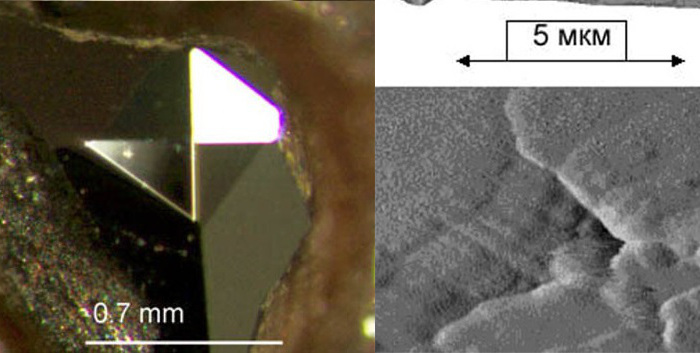Scientists come closer to the industrial synthesis of a material harder than diamond

Photo of a Vickers indenter made of ultrahard fullerite. Courtesy of MikhailPopov
In their work, the scientists note that diamond hasn’t been the hardest material for some time now. Natural diamonds have a hardness of nearly 150 GPa, but ultrahard fullerite has surpassed diamond to become first on the list of hardest materials with values that range from 150 to 300 GPa.
All materials that are harder than diamond are called ultra hard materials. Materials softer than diamond but harder than boron nitride are termedsuperhard. Boron nitride, with its cubic lattice, is almost three times harder than the well-known corundum.
Fullerites are materials that consist of fullerenes. In their turn, fullerenes are carbon molecules in the form of spheres consisting of 60 atoms. Fullerene was first synthesized more than 20 years ago, and a Nobel Prize was awarded for that work.
The carbon spheres within fullerite can be arranged in different ways, and the material’s hardness largely depends on just how interconnected they are. In the ultrahard fullerite discovered by the workers at the Technological Institutefor Superhard and Novel Carbon Materials (FSBITISNCM), C 60 molecules are interconnected by covalent bonds in all directions, a material scientists call a three-dimensional polymer.
However, the methods providing production of this promising material on an industrial scale are not available yet. Practically, the superhard carbon form is of primary interest for specialists in the field of metals and other materials processing: the harder a tool is, the longer it works, and the more qualitatively the details can be processed.
What makes synthesizing fullerite in large quantities so difficult is the high pressure required for the reaction to begin. Formation of the three-dimensional polymer begins at a pressure of 13 GPa, or 130,000 atm. But modern equipment cannot provide such pressure on a large scale.
The scientists in the current study have shown that adding carbon disulfide (CS 2 ) to the initial mixture of reagents can accelerate fullerite synthesis. This substance is synthesized on an industrial scale, is actively used in various enterprises, and the technologies for working with it are well-developed.
According to experiments, carbon disulfide is an end product, but here it acts as an accelerator. Using CS 2 , the formation of the valuable superhard material becomes possible even if the pressure is lower and amounts to 8GPa. In addition, while previous efforts to synthesize fullerite at a pressure of 13 GPa required heating up to 1100K (more than 820 degrees Celsius),in the present case it occurs at room temperature.
“The discovery described in this article (the catalytic synthesis of ultrahard fullerite) will create a new research area in materials science because it substantially reduces the pressure required for synthesis and allows for manufacturing the material and its derivatives on an industrial scale”, explained Mikhail Popov, the leading author of the research and the head of the laboratory of functional nanomaterials at FSBI TISNCM.
Note: Ultrahard fullerite is described in greater detail in the following scientific publications:
-
Is C 60 fullerite harder than diamond? V.Blank, M.Popov, S.Buga, V.Davydov, V.N. Denisov, A.N. Ivlev, B.N. Mavrin, V.Agafonov, R.Ceolin, H.Szwarc, A.Rassat. Physics Letters A Vol.188 (1994) P 281-286.
-
Structures and physical properties of superhard and ultrahard 3D polymerized fullerites created from solid C60 by high pressure high temperature treatment. V.D. Blank, S.G. Buga, N.R. Serebryanaya, G.A. Dubitsky, B. Mavrin, M.Yu. Popov, R.H. Bagramov, V.M. Prokhorov, S.A. Sulynov, B.A. Kulnitskiy and Ye.V. Tatyanin. Carbon, V.36, P 665-670 (1998)
-
Ultrahard and superhard phases of fullerite C60 : comparison with diamond on hardness and wear. V.Blank, M.Popov, G.Pivovarov, N.Lvova, K.Gogolinsky, V.Reshetov. Diamond and Related Materials. Vol. 7, No 2-5 (1998), P 427-431
MIPT’s press service would like to thank scientists for their invaluable help in writing this article.
Media Contact
More Information:
http://mipt.ru/en/news/harder_than_diamond_201409All latest news from the category: Materials Sciences
Materials management deals with the research, development, manufacturing and processing of raw and industrial materials. Key aspects here are biological and medical issues, which play an increasingly important role in this field.
innovations-report offers in-depth articles related to the development and application of materials and the structure and properties of new materials.
Newest articles

“Nanostitches” enable lighter and tougher composite materials
In research that may lead to next-generation airplanes and spacecraft, MIT engineers used carbon nanotubes to prevent cracking in multilayered composites. To save on fuel and reduce aircraft emissions, engineers…

Trash to treasure
Researchers turn metal waste into catalyst for hydrogen. Scientists have found a way to transform metal waste into a highly efficient catalyst to make hydrogen from water, a discovery that…

Real-time detection of infectious disease viruses
… by searching for molecular fingerprinting. A research team consisting of Professor Kyoung-Duck Park and Taeyoung Moon and Huitae Joo, PhD candidates, from the Department of Physics at Pohang University…





















